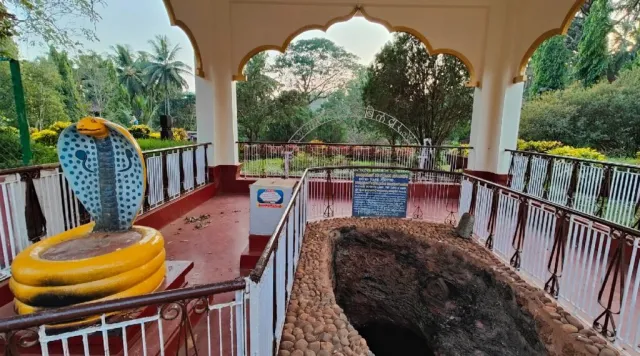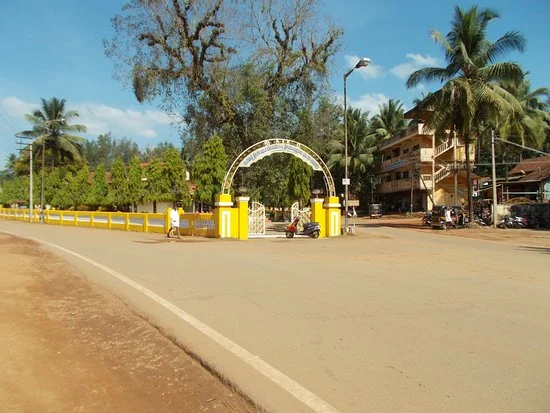Sri Kukke Subrahmanya Temple (Subramanya)
Kukke Subramanya: A Sacred Abode in Karnataka

Situated in the verdant Western Ghats of Karnataka, Kukke Subramanya is the prime Hindu pilgrimage site devoted to Lord Subramanya (also called Kartikeya or Murugan), the god of snakes and protection. This temple town has gained fame for its peaceful setting, abundant mythological background, and hallowed rituals hundreds of thousands of devotees arrive here each year.
The History and Mythology of Kukke Subramanya
The history of Kukke Subramanya is interwoven with Hindu mythology extending back into the Puranic era. Legend states that Lord Subramanya came here after defeating the demon Tarakasura to hide in these forests. The incarnation was welcomed by Vasuki, The Serpent King. Then Subramanya promised Vasuki that this place would be his sanctuary where devotees would come seeking protection and release from Sarpa Dosha (snake-related curses in astrology).
From the Sanskrit word for basket, the name "Kukke" also means that they used a basket to carry Lord Subramanya to this place. Local stories indicate that a basket created with divine powers protects this spot, sheltering all who come for Lord's blessings.
Architecture of Kukke Subramanya Temple
Kukke Subramanya Temple is a sublime Dravidian temple with intricate pillars, an unusual gopuram (gateway), and finely detailed stone carvings. After walking through the entrance is the glorious sanctum sanctorum where Lord Subramanya resides in the form of a divine anthill, clearly signifying close association with the serpent world. The shrine features an idol of Vasuki and other serpent deities, emanating a sense of protection against the fear of snakes and certain astrological doshas.
Faced with Hindu mythological scenes, the walls of the main sanctum and wooden panels are adorned with sculptures that enhance the temple's beauty and exude peaceful and reverential vibes.
Religious Significance and Festivals
Kukke Subramanya Temple is a very important pilgrimage site especially for those who seek a remedy for 'Sarpa Dosha'. Worship in the temple is said to bring relief from planetary problems and afflictions caused by serpents. The famous rites there are Sarpa Samskara Pooja and Ashlesha Bali, which involve offerings to snake gods and prayers for the removal of obstacles due to 'Sarpa Dosha.'
Great pride is taken in celebrating numerous festivals there. Among the most important festivals celebrated in the temple are:
- Subramanya Shasti: This festival occurs in December and celebrates the victory of Lord Subramanya over Tarakasura. This six-day event sees an enthusiastic gathering of devotees who recite hymns, perform abhishekas to Lord Subramanya, and jubilate his victorious deeds.
- Navaratri: This nine-night festival celebrating the different forms of Divine Mother is observed with huge enthusiasm in the temple and draws large gatherings of devotees.
Scenic Beauty and Natural Attractions
Kukke Subramanya is not only known for its religious significance but also its picturesque natural beauty. The town is surrounded by the dense greenery of the Western Ghats, home to rivers, streams, and mountains, making it a scenic retreat for nature lovers.
Some popular places around Kukke Subramanya include:
-
Kumaradhara River: Flowing close to the temple, this river is considered holy, and devotees often take a dip at Mathsya Tirtha, a sacred ghat, before entering the temple to purify themselves. Another ghat, Panchami Tirtha, located along the banks, features the Somanatha Temple and the Brindavanas of the Swamijis from the Subramanya Mutt.
-
Abhaya Ganapathi: Located on the left side of the main road to Kumaradhara, about 0.45 km from the main temple, this shrine houses one of the largest monolithic statues of Lord Ganesha, standing at 21 feet tall. The temple is built in a distinct Nepali architectural style. Known as Abhaya Ganapati, meaning "Fearless Ganapati," it is a prominent spot for devotees seeking blessings for a fearless and obstacle-free journey.
-
Kashikatte: Situated about three furlongs from the temple on the main entrance road to the Kshetra, this spot features shrines dedicated to Anjaneya (Hanuman) and Vigneshwara (Ganesha).
-
Biladwara Cave: A sacred cave about four furlongs from the temple, believed to be where Vasuki, the serpent king, took refuge from Garuda while performing penance. The cave, approximately 10 meters in length, features both an entrance and an exit, making it a spiritually significant spot for devotees visiting Kukke Subramanya.
-
Adi Subramanya: This shrine, located near the main temple, is considered the original seat of Lord Subramanya. It holds great importance for performing rituals such as Sarpa Samskara and Ashlesha Bali, aimed at alleviating Sarpa Dosha (serpent curses).
-
Sri Subramanya Mutt: Located southeast of the main temple, this Dwaita Mutt follows the Madhva philosophy. It plays a vital role in the religious and spiritual activities of the temple complex.
-
Vedavyasa Samputa Narasimha Devaru: Situated within the inner quadrangle of the main temple’s southeast section, this shrine is managed by the Sri Subramanya Mutt and is dedicated to Lord Narasimha.
-
Vanadurga Devi Temple: Managed by the Sri Subramanya Mutt, this temple lies about 1 km from the main temple along the roadside. It is dedicated to Goddess Vanadurga, a fierce manifestation of Durga Devi believed to protect devotees from negative energies.
-
Kumara Parvatha: One of the highest peaks in the Western Ghats, standing at around 4,000 feet above sea level. This peak is popular among trekkers and nature enthusiasts for its challenging trails and breathtaking views. Guides are available for devotees and adventure seekers interested in exploring the mountain.
-
Pushpagiri Wildlife Sanctuary: Located nearby, this sanctuary is renowned for its rich biodiversity, home to various species of flora and fauna native to the Western Ghats.



Access and Accommodation
Kukke Subramanya is well-connected by road, rail, and air. Mangalore, the nearest major city, is around 100 km away and offers an airport and railway station. From there, one can reach Kukke Subramanya by bus or taxi. The temple town provides various lodging options, from budget guesthouses to comfortable hotels, catering to pilgrims and tourists alike.
Tips for Pilgrims Visiting Kukke Subramanya
- Dress Appropriately: Visitors are expected to dress modestly to respect the temple’s traditions.
- Book Rituals in Advance: Rituals like Sarpa Samskara are highly sought after, so advance booking is advisable.
- Observe Temple Etiquette: Refrain from carrying leather items or engaging in photography within the temple premises.
- Plan for the Trek: If planning to visit Kumara Parvatha, be prepared for a moderately challenging trek with sturdy shoes, water, and snacks.
Kukke Subramanya Temple offers a unique blend of spirituality, nature, and cultural heritage. It serves as a place of hope and solace for devotees from all over India and abroad, who seek divine intervention and relief from their troubles. Whether one visits for spiritual reasons, the scenic beauty, or simply to experience Karnataka’s rich heritage, Kukke Subramanya is a destination that leaves an indelible mark on every visitor.